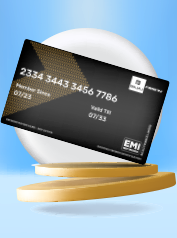
Table of Content
Learn how ACH Mandate simplifies payments with secure, automated, and paperless transactions.
The full form of ACH Mandate is Automated Clearing House Mandate. An account holder authorises their bank to make automatic, recurring payments from their account. This process operates under the National Automated Clearing House (NACH) system, streamlining transactions like EMIs, subscription fees, utility bills, and more.
An ACH Mandate ensures seamless, paperless payments without manual intervention. This mandate can only be registered by the individual or entity initiating payments (payer) and is applicable for both ACH credit and ACH debit transactions.
An Automated Clearing House (ACH) transaction involves the transfer of funds between two bank accounts. One account initiates the transaction (payer), while the recipient’s bank account reflects the credit. These transfers can be for payments like EMIs, salary deposits, or tax refunds.
Unlike traditional payment methods, ACH transfers are faster, cost-effective, and secure. Some banks may impose ACH-related fees, but this varies across financial institutions. Typically, direct deposits (like salary credits) do not attract fees, while certain direct payments might have a nominal charge.
Setting up an ACH mandate offers multiple benefits, making it a preferred choice for recurring payments. Here’s a detailed look at its key features and benefits:
Faster Transactions
ACH payments process transactions within 24 hours, ensuring faster payments compared to traditional methods. This reduces the risk of delays for payments like EMIs, utility bills, and subscriptions.
Convenience
With an ACH mandate, payments are automated, eliminating the need for manual intervention each month. It allows for timely payments of recurring expenses like rent, credit card bills, and EMIs.
Enhanced Security
ACH payments use advanced encryption and OTP-based authorisation to ensure secure processing. This minimises the risk of fraud, making ACH payments safer than paper-based transactions.
An ACH mandate can be broadly classified into two main types based on the nature of the payment process. Here’s a breakdown of each type:
Fixed ACH Mandate
A fixed ACH mandate is used for recurring payments where the payment amount remains constant over a specified period. This type of mandate is ideal for loan EMIs, rent payments, and subscription fees. The bank debits a fixed amount on the due date, and the payer knows the exact amount in advance.
Variable ACH Mandate
A variable ACH mandate is used for payments where the amount varies for each transaction. People commonly use it for credit card payments, utility bills, and usage-based subscription fees. The payer authorises the payee to debit the required amount from their bank account, but the actual amount may change each month based on usage or outstanding dues.
The purpose of an ACH transfer depends on the type of transaction — ACH Credit or ACH Debit.
ACH Direct Payments
ACH direct payments are outgoing payments made by an individual or business. You can use them for:
EMI payments
Tax payments
Subscription fees
Utility bills
Mortgage payments
Recurring investments
Tuition fees
Insurance premiums
ACH Direct Deposits
ACH direct deposits are incoming payments received by an individual or entity. They are often used for:
Salary payments (payroll)
Pension payments
Tax refunds
Dividend payouts
Loan disbursements
Expense reimbursements
Interest payments
Most banks in India provide the ACH facility under NACH. Here are some major banks offering the service:
HDFC Bank
Axis Bank
State Bank of India (SBI)
ICICI Bank
Bank of Baroda (BoB)
RBL Bank
To register for an ACH mandate, you can either collect the form from the bank or download it from the bank's official website. Submit the filled form along with required documents like a cancelled cheque and identity proof.
You can register an ACH mandate using two methods:
Through your bank
Through the NSE Mutual Fund platform
Registration of ACH Mandate Via Banks
Follow these steps to register your ACH mandate through a bank:
Visit your bank’s net banking portal or mobile app
Log in using your credentials (ID and password)
Select 'ACH Mandate Registration' or ‘NACH Mandate’
Enter key details like bank account number, MICR code, IFSC code, and payment instructions
Verify your mobile number and authenticate the process via OTP
Submit the form and track the status via the banking portal
Registration of ACH Mandate Through NSE
Here’s how to register for an ACH mandate through NSE:
Visit the NSE Mutual Funds website and click on 'CRM'.
Select 'ACH Mandate Registration' from the available options.
Enter your Investor Identification Number (IIN) or Customer ID.
Select 'New' as the mandate type when asked for the UMRN (Unique Mandate Reference Number).
Choose 'e-Mandate' and set the mandate type to 'Online'.
Ensure your bank supports e-mandate services and is registered at the IIN level.
Click on 'Submit' to confirm your e-Mandate registration.
Enter your Aadhaar number for identification.
Receive an OTP on your registered mobile number.
Enter the OTP to authenticate and complete the registration process.
Note: The steps may differ slightly depending on the bank's or platform's requirements. It’s best to follow the instructions provided on the official website.
To set up an ACH mandate, you need to fill in the following details on the ACH form:
Bank account number
MICR code
IFSC code
Bank name
Type of transaction (credit/debit)
Amount (in figures and words)
Phone number
Email ID
Once submitted, the form is processed, and your payments are automated.
ACH transfers are usually free, but some banks may charge fees. These fees are often related to payment types and the institution's policies. Common ACH fees include:
Debit fee – When funds are debited from your bank account
Credit fee – The bank credits funds to your account, applying a credit fee for the transaction
Service fee – A general charge for processing the transaction
It’s best to check with your bank about any applicable ACH fees.
Many confuse ACH with ECS (Electronic Clearing Service). Here’s a simple comparison:
Criteria |
ACH (Automated Clearing House) |
ECS (Electronic Clearing System) |
|---|---|---|
Rejection Rate |
Low rejection rate due to real-time validation |
Higher rejection rate as it relies on manual intervention |
Settlement Time |
Same-day settlement or within 24 hours |
Takes 3-4 days as it uses batch processing |
Dispute Resolution |
Dispute management system in place |
No formal dispute resolution system in place |
Process Type |
Fully automated with API-based system |
Manual process requiring human intervention |
Data Security |
Highly secure with encryption and authentication |
Less secure due to manual handling |
Mode of Operation |
Operates under NACH (NPCI) |
Operates under RBI ECS scheme |
Error Handling |
Real-time error correction possible |
Errors may persist due to batch-wise processing |
Usage |
Used for direct deposits, utility payments, EMI payments |
Used for bulk payments like dividends, pensions |
Authorisation Method |
Digital authorisation via e-mandates |
Paper-based mandates requiring manual approvals |
Speed of Process |
Faster due to automated, API-based approach |
Slower due to batch processing and manual intervention |
Now that you know the meaning of the ACH mandate, understand the two types of ACH transfers:
ACH Credit
An ACH Credit is a transaction where the payer transfers funds directly from their bank account to a recipient's account. For instance, if you schedule a utility bill payment through your bank's mobile app, the bank sends money from your account to the utility company’s bank account. People often use it for payments like rent, credit card bills, and school fees.
ACH Debit
An ACH Debit allows the recipient (like a lender or service provider) to automatically pull funds from the payer's bank account on a set schedule. For example, if you set up EMI auto-debit for a personal loan, the lender deducts the EMI directly from your bank account on a fixed date each month. People also use it for subscription payments and loan repayments.
The ACH (Automated Clearing House) mandate allows financial institutions to initiate recurring payments on behalf of account holders. Essentially, you receive an ACH mandate when your payment is due.
You can log in to your bank’s mobile banking portal and navigate to the service request. Select the account-related ACH section to track your ACH mandate status. This navigation process may vary depending on the bank.
An ACH payment is a recurring transaction set up between you and a business. It facilitates straightforward direct payments electronically.
Yes, the ACH mandate is safe. Transactions are encrypted, and the process follows stringent security protocols.
Yes, you will have to pay a penalty fee if an ACH payment gets declined. To avoid these charges in future billing cycles, you must resolve the issue. The bank may also levy other charges; however, it can vary from one bank to another.
e-ACH is an electronic version of ACH that allows the use of online portals and electronic transfers to facilitate transactions.
On the other hand, e-mandate is a payment service introduced by NPCI (National Payments Corporation of India) to facilitate recurring payments.
Most of us have ACH payments scheduled and pre-authorised regularly for certain payments and subscriptions. However, if you are looking to cancel your ACH mandate, you can choose to opt out.
Once you contact the bank, you will be required to submit a request to cancel the ACH mandate. Once submitted, your ACH mandate cancellation will be processed and completed within 3-5 business days, depending on the bank.
Here’s what you need to successfully make ACH payments.
The recipient’s financial institution’s name
The recipient’s account number
The type of account provided by the financial institution
The IFSC code of the bank for Indian transactions or the ABA routing number for international transactions












